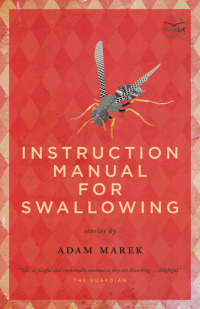The Stone Thrower by Adam Marek
 Saturday, April 27, 2013 at 7:16PM
Saturday, April 27, 2013 at 7:16PM 
First published in Great Britain in 2012; published by ECW Press on April 1, 2013
The stories in Adam Marek's debut collection, Instruction Manual for Swallowing, were absurdist sketches of life. Many of the stories in The Stone Thrower are, if not conventional, at least more grounded in reality. Some are about boys learning what it is to be a man. A boy learns about death and mercy by helping his father save (and sometimes kill) baby birds. A boy steals a fish in a country where life is cheap. A damaged boy's virtual pet becomes ill and begins infecting other virtual pets.
Most of the stories have a dark side. A father's desperate attempt to deal with his son's allergy to bee stings goes wrong. A boy kills chickens with unerringly thrown stones. In the book's best story, a boy battles sharks as a man seeks revenge.
There's greater variety in these stories than there was in the first collection, in style and content. As was true of Instruction Manual for Swallowing, some of my favorites delve into science fiction. In a future where soldiers are protected by nanosuits and suicide bombers target the most specialized children, a boy and a girl who were once friends become adversaries -- a change of heart that the boy inadvertently caused and that he takes an extraordinary step to rectify. In another story set in the future, a woman who took extraordinary measures to save apes from extinction by cloning them is distressed that they are being used as docile workers, tending a plantation of palm trees. In a story set in an unspecified time and location, a woman strikes a violent blow against repression.
The stories in The Stone Thrower generally aren't as bizarre as those in Instruction Manual for Swallowing, although one about a boy whose seizures cause earthquakes (in the form of a letter seeking funds to research the condition) is an amusing exception. A couple of stories lack development or context, leaving me puzzled as to their meaning. A couple of stories never quite get going, and so fail to deliver the impact that Marek intended. Most of the stories, however, are powerful, and some are gut-wrenching. I continue to be impressed with Marek's imaginative view of the world, and I'm even more impressed with his growth as a writer.
RECOMMENDED
